Welcome back to Monday Magic: COVID Edition. While the last, now fifteen weeks, have been a difficult time to play games of Magic, let alone focus on new cards and set releases, that hasn’t stopped Wizards of the Coast from contuing to release their product at roughly their regular annual schedule.
Indeed, since just March 2020, next week Wizards is poised to release its fourth set, starting with its jumbled Ikoria release, followed by Core Set 2021 and its associated booster-based supplement Jumpstart, and soon, the tourney-focused supplement for the year, Double Masters. This says nothing of its Ikoria Commander decks and its summer Secret Lair premium products.
In a normal year, that’s a lot of cards to push out in a 5 month period. During a pandemic? That’s down right staggering.
On the one hand, you can’t really blame them. That die had already been cast months ago. Their release schedule is set at least a year in advance, and most of these products were already in production or already complete once the shutdowns started. Despite some minor shipping delays coming out of China early on, the company’s product operations have seen little disruption, something for which we’re sure it’s parent Hasbro was quite happy about. Capitalism has to capitalism after all.

On the other hand, it would be foolish to pretend that the community has the same level of interest and enthusiasm as they normally would. With the tournament circuit all but shuttered, a majority of its player base unable to interact with one another in person (hello!), many scaling back purchases due to financial concerns, and local game stores – the lifeblood of Magic’s existence – either temporarily closed or operating at a fraction of their normal levels, the product may be flowing, but outside of the internet you’re not seeing the same rapacious consumption of the game as you normally would.
Case in point: although it has been out nearly a month now, the 2021 Core Set is still worth talking about. Due to the delayed pacing of how casual Magic players are taking in Magic content right now, M21 is still very much a new set in their eyes.
With that in mind, this week and next we’re going to dive into this set and look at some of the most worthwhile multiplayer cards that Core 2021 has to offer. While there certainly are some Magic players that lament core sets for being a bit on the boring side, don’t be fooled into thinking there aren’t copious multiplayer friendly cards worthy of your attention.
So let’s dive into the top ten most versatile Commander cards of Core 2021. As always, the goal of this list is to focus is on which cards can be utilized in the most situations and deck styles more so than those that are simply the most powerful or most valuable. I’m also focusing on new cards only – no reprints.
Even taking those restrictions into account, it wasn’t easy to narrow them down. But here we go!
Honorable Mention #1: Vito, Thorn of the Dusk Rose
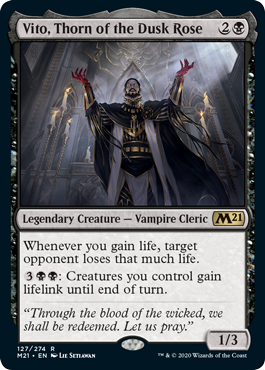 In many, if not nearly all Magic formats, speed is of the utmost importance. The longer your opponent sticks around, the more opportunities there are for them to eliminate you before you eliminate them. As a result, when it comes to matters of tempo and efficiency, having particularly dangerous passive effect in creature form is particularly advantageous: it combines a potential attacker in combat with the tactical benefits that you might gain from an artifact or enchantment.
In many, if not nearly all Magic formats, speed is of the utmost importance. The longer your opponent sticks around, the more opportunities there are for them to eliminate you before you eliminate them. As a result, when it comes to matters of tempo and efficiency, having particularly dangerous passive effect in creature form is particularly advantageous: it combines a potential attacker in combat with the tactical benefits that you might gain from an artifact or enchantment.
In Commander, however, the opposite is usually true. Games are longer and more complex, and creature removal is plentiful in nearly every form. Unlike it speedier counterparts, if you have the choice between creature and noncreature permanents with the same effect, the noncreature option usually is more favorable.
Brother Vito has the potential as one of those exceptions.
For three mana, this 1/3 vampire legend is a walking talking iteration of the dangerous Sanguine Bond – at two mana less. Were it just that ability alone though, it would still pale compared to its inanimate counterpart. Yet Vito also brings with it the one thing Sanguine doesn’t do by itself – give you the ability to gain life to set off its trigger. Although a five mana activation to give all your creatures lifelink for the turn would be costly nearly anywhere else, in Commander that is manageable. Doubly so if you actually have several creatures worth dragging into combat with.
Moreover, if you actually are of the fair-minded types, because a 1/3 creature with no evasion isn’t exactly the most dangerous card to deal with in this setting, it would be a more honorable option if you absolutely must also have Exquisite Blood in the deck alongside it.
Honorable Mention #2: Sublime Epiphany
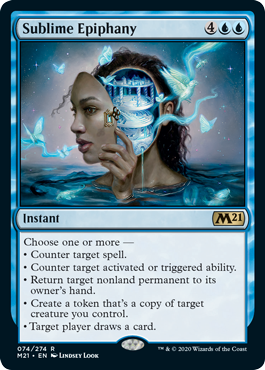
I have long held a theory that one of the easiest ways, if subtle, ways to determine the scope and tenure of a Magic player is to see at what stage they will stop utilizing counterspells as their casting costs go up. For many Legacy and Vintage players, that generally stops around one mana; in reality, the most common counters they use don’t require any mana at all (looking at you Force of Will). Most old school casual Magic players, they are hardwired to think that two mana is the most optimal, thanks to a bevy of wildly available counters in that era (Counterspell, Remove Soul, Mana Leak, etc.). Casual players from the Mending Era forward generally assume most counters are in the 3-4 mana range, with Cancel as the default, and are more willing to operate with that mindset.
The one thing that almost all Magic players agree on, though, is that a counter card costing above four mana REALLY better be worth it. The more mana the counter requires, the more mana you have to leave available to use it – which means purposely doing less on your own turn. We’ve expounded at times on the occasional usefulness of 5+ mana cards such as Counterlash before, but they are best when used sparingly, even in Commander.
Sublime Epiphany is another in that category.
Technically speaking, Sublime Epiphany isn’t solely a counter card, but much like how Cryptic Command can be used for modes other than countering, it’s rarely used in that capacity. The same will be true here. Sublime actually goes one step further than Cryptic even by letting you select all of its modes, including countering a spell and/or triggered or activated ability, bounce a card, draw a card, and copy one of your creatures a la Cackling Counterpart. Make no mistake: Sublime Epiphany gives you quite a bang for your buck and is definitely worthwhile to consider in an EDH deck due to the volume of toolkit-like variety it offers in a single card – at Instant speed no less. So much so that it’s technically even worthwhile without its counter functions. Still, careful consideration will be made to get its maximum effect.
Number Ten: Radha, Heart of Keld
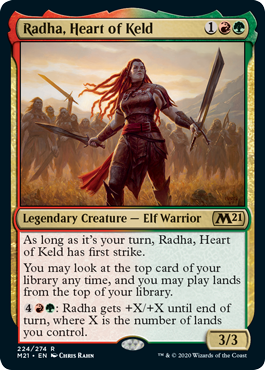 One of the recurring themes of M21 is a series of Dominaria-based legendary creatures from across the timeline. While some of the legends in this set existed hundreds of years prior to the current storyline, Radha is closer to the present – relatively speaking. In this case, we see the Radha just after the events of Time Spiral when she embraced her role as the leader of the Keld people – putting it between the impetuous youth version seen in Planar Chaos and the wizened leader in the Dominaria set. And it doesn’t disappoint.
One of the recurring themes of M21 is a series of Dominaria-based legendary creatures from across the timeline. While some of the legends in this set existed hundreds of years prior to the current storyline, Radha is closer to the present – relatively speaking. In this case, we see the Radha just after the events of Time Spiral when she embraced her role as the leader of the Keld people – putting it between the impetuous youth version seen in Planar Chaos and the wizened leader in the Dominaria set. And it doesn’t disappoint.
For starters, this Radha is a 3/3 for three mana. Radha also has a rider that gives her First Strike on your turn, giving her an added edge when going on the attack (as any decent Keldon would appreciate). But it is her two others abilities that really make her a desirable card.
Her second ability states that you are able to look at the top of your library whenever you wish (once a rare ability but becoming more common in recent years) and that you may play lands from the top of your library. This doesn’t give you extra land drops but is nevertheless incredibly useful for ramping up your deck by being able to reduce the number of land draws you make and increasing the likelihood of drawing into cards in need of that mana.
Tied into that is her final ability, which for six mana states that Radha gets bigger equal to the number of lands you control. Six mana for a single activation can be seen as a bit costly, but it also makes her quite dangerous to then attack with. At the bare minimum, assuming you had six lands to activate it in the first place, that’d make Radha a 9/9 First Striker on you turn. In the later stages of a game, it could easily be twice that. This makes her quite a potent fighter on the battlefield to be wary of, and particularly dangerous as a Commander – should you opt to go that route.
Not bad for three mana.
Number Nine: Brash Taunter
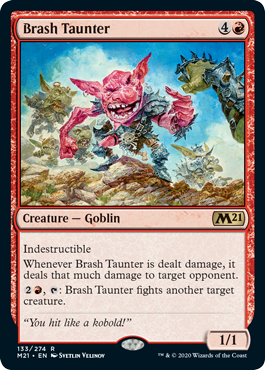 In all of Magic’s many years in existence, there has rarely been a shortage of goblins running around. With few exceptions, the game has long enjoyed different iterations of goblins doing just about every chaotic, explosive, risky, and wildly stupid act you can think of that a goblin may try. Some goblins serve as mere fodder for a larger ambition, whereas other times the amassing of a goblin army to swarm with is the main focus.
In all of Magic’s many years in existence, there has rarely been a shortage of goblins running around. With few exceptions, the game has long enjoyed different iterations of goblins doing just about every chaotic, explosive, risky, and wildly stupid act you can think of that a goblin may try. Some goblins serve as mere fodder for a larger ambition, whereas other times the amassing of a goblin army to swarm with is the main focus.
And then, on rare occasion, you get a goblin card that stands out for rising to a potential above the rank and file goblins out there and can stand alone as a useful, if eccentric card. Brash Taunter is amusingly one such card.
The meta on the card is also too good not to revel in.
See, back in the early days, one of the more widely used goblins was Mogg Maniac, a 1/1 which stated that whenever it was dealt damage, it would deal that much damage to an opponent. While this meant you could buff it up and run it at an opponent or have it serve as a deterrent blocker, most Red players figured out that its most efficient purpose was to lob creature damage spells at it such as Acceptable Losses, or more commonly, Spitting Earth, using it as a conduit to funnel damage at an opponent instead.
Brash Taunter is a Mogg Maniac who doesn’t die afterwards, thanks to it being Indestructible – thereby letting you leverage him on more than one front. While he is more costly at five mana versus two, the indestructibility is hard to overstate.
What’s more, Brash Taunter also brings with it its own ammunition, avoiding the need to waste creature damage cards on your own permanents. Instead, for three mana, Brash Taunter lets you fight another creature on the battlefield (presumably the biggest creature out there), and then toss the damage at an opponent. Which means that in addition to serving a decent job on defense, it likely can also be quite effective at dishing out 5-6 damage every round with relative ease in Commander games. With a particularly large creature on the battlefield, its taunts could turn down right deadly in a hurry.
Number Eight: Angelic Ascension / Soul Sear
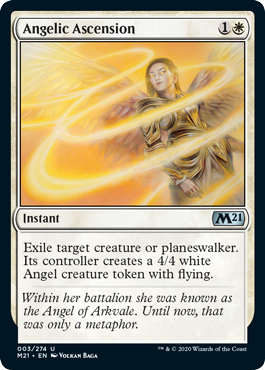
Speaking of removal, M21 brings with it a handful of under-the-radar removal cards that are surprisingly worthwhile for consideration in an EDH deck or two thanks to their modest costs and wide-ranging application. Core sets have a tendency to waver back and forth over the years between being generous or stingy with spot removal cards. On the feast or famine spectrum, M21 will not leave you wanting.
Angelic Ascension and Soul Sear particularly stand out in this regard, with each offering up a color-appropriate answer to a potentially problematic creature or planeswalker problem at Instant speed and for almost no cost.
On the White side lay Angelic Ascension. It states that for two mana, you can exile any targetable creature or planeswalker. In exchange, its controller gets a 4/4 Flying angel. In Standard or Limited that sort of move could be considered one of parity or even desperation – giving a midsized flier to your opponent is generally dangerous if you’re the only option to attack. In Commander, however, given the abundance of large and dangerous creatures or well-defended planeswalkers running around, this is likely to almost always be a tradeoff in your favor. Indeed, in an EDH setting, that degree of efficient spellcasting puts it into Swords to Plowshares / Path to Exile territory when factoring in that it can handle planeswalkers too.
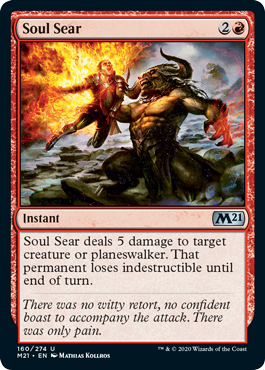 Red’s Soul Sear is only slightly more tempered but still highly worthwhile in its own right despite being limited in scope towards damaging creatures and planeswalkers. Still, three mana to deal 5 damage as an Instant to such a target is on the favorable side of the damage-to-cost damage curve and worth considering.
Red’s Soul Sear is only slightly more tempered but still highly worthwhile in its own right despite being limited in scope towards damaging creatures and planeswalkers. Still, three mana to deal 5 damage as an Instant to such a target is on the favorable side of the damage-to-cost damage curve and worth considering.
When you also factor in that it strips indestructibility from its target as well, it can make for an excellent surprise removal card that your opponent may not always expect. 5 damage may not be enough to take out he largest battlefield problems in Commander, but it’s capable of handling more targets than you may think – or at least puts enough of a dent into them to pair with something else to finish the job.
Number Seven: Chromatic Orrery
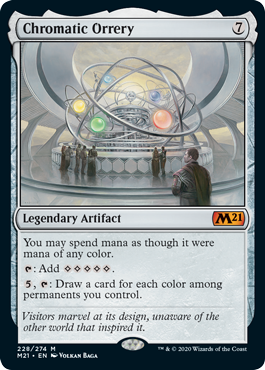
It’s fairly evident that while M21 itself is not a throwback or nostalgia set, it’s hard to ignore the prevalence of historical characters and clear nods to the past. Few non-creature cards within the set are perhaps more noteworthy in that respect than Chromatic Orrery, an appreciable, if somber reminder about the plane of Mirrodin.
Of course, its flavor isn’t what lands it on this list. Rather, it’s the degree to which it takes the next logical leap in mana rocks – something for which both Magic, and Commander especially, are quite fond of. And this Orrery may be the splashiest to come along in quite some time.
The general rule of thumb for mana rocks is a 2-1 cost to mana ratio, meaning that if it had cost eight mana, you could expect to get 4 mana out of it. In this case, however, this multifunctional artifact only costs seven mana and generates a whopping five to use, nearly paying for itself as soon as it hits the battlefield – an effective delta of just two mana.
This fact alone makes it incredibly versatile in nearly any deck needing a sizable ramp kick – especially those without access to Green. But that is only half of its usefulness. There is also its chromatic side, which offers a pair of useful multicolor rewards.
First is the fact that this artifact states you can spend mana as though it were any color, instantly making that 5 colorless mana any combination of colors you may want or need at that moment – along with everything else. This makes it easier in decks requiring heavy colored mana spells or activations and is especially handy as a mana fixer in decks running three or more colors.
This is reinforced with its second activated ability, which states that for five mana you can draw a card for each colored permanent you have. Repeatable draw is always a useful asset in Commander settings, ensuring that if you don’t need to cast something at the moment you can instead reload your hand by drawing more cards instead.
Card draw, mana filtering, and mana ramp? All in a single colorless artifact? And for only 7 mana? That’s a lot to jam into a single card, and simply put, that’s almost impossibly hard to say no to whether you’re running a deck with one color or five. Chromatic Orrery is easily among the most versatile EDH cards in the set. Yet the reason it doesn’t end up higher on this list is a pragmatic one: Chromatic Orrery is a classic example of a card that’s almost too much of a good thing. Given the numerous advantages it provides, coupled with it being an artifact, this thing will enter any Commander game with a giant target on its back simply begging to be smashed. As such, though powerful, it’s also the kind of card that may not be terribly long lived in many games – which does damper its efficacy just a tad.
Number Six: Garruk, Unleashed
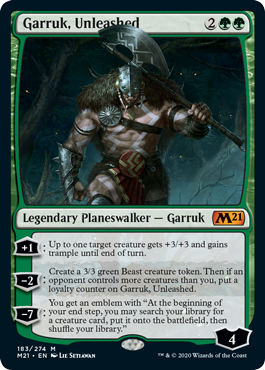
First off, welcome back Garruk! We know this beast mage took a long unplanned sabbatical wherein he lost his mind and tried to murder a bunch of people, but since his return in Eldraine a greeting was already overdue. And it would seem that he has picked up right where he left off.
Planeswalker cards, by their nature, are utility-driven in nature, with several disparate activations that can be utilized at different times for maximum effect. Some planeswalkers (particularly those in the Planeswalker Decks) are designed to be highly generic in their effects, as their purpose is usually to introduce players to the idea of using them in the game. Other planeswalkers are highly tailored to a specific purpose, rewarding you for building a deck that revolves around a particular style or mechanic. Of the 11 planeswalkers in Core Set 2021 Garruk, Unleashed is arguably the one that is the most balanced, being purposeful but with wide-ranging application.
Garruk, Unleash enters the battlefield with four loyalty for four mana, which is a decent if average base to start with. His first ability, however, gets right to work. His +1 ability gives one creature +3/+3 and Trample for the turn, giving you a repeatable Predator’s Strike / Awaken the Bear every round. This alone is handy in combat, turning even modest midrange creatures into large and dangerous Tramplers to deal with as Green is every so good at doing. Its only down side is that it presupposes you have creatures to use it on.
Luckily, Garruk’s second ability addresses that in a help and innovative way. For -2, you get a 3/3 beast token. Yet rather than a basic token generator, this is essentially Pulse of the Tangle repurposed. That is, after creating the token, if an opponent has more creatures than you, it adds a loyalty counter back! It’s pretty common to be outnumbered creature-wise at some point in Commander games, ensuring that odds are you’ll be able to take advantage of the activation discount a fair amount of time.
The first two abilities together are enough to work with on a regular basis by generating and buffing tokens. But no good planeswalker would be without a decent ultimate, and Garruk doesn’t disappoint here either. For -7, Garruk goes full-on beast mode by bestowing you an emblem that lets you search your deck for any creature and put it directly on the battlefield at the end of every turn, completely unrestricted by casting cost, size, or color. Simply grab any creature. Which practically begs you to rush the ultimate.
All told, whether it’s a combat advantage, token generation, or creature tutor, Garruk has you covered, easily earning his moniker for this card. Each provides a distinct tactical advantage depending on your circumstances, and it can work in nearly any Green deck running a creature-based offensive.
So, you know, a Green deck.
That’s it for now! Check back in two weeks for Numbers 1-5!
300th Showcase Celebration!
In honor of the 300th Commander Spotlight article, and as an appreciation for reading them all these years, I’m still raffling off a fitting $30 store credit to TCGPlayer.com as a means of giving back and let you get some all new (or old) cards for your own Commander decks. Over the next 20 days you have a chance to enter. Thanks, and good luck!
![]()
Would these cards have been on your own top ten? Tell us over on our social media!
